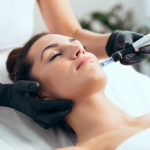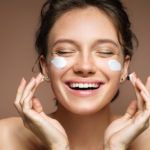Photo By RyanKing999 at istock
Fungus is everywhere. It lives in air, water, soil, and plants, and scientists have identified 120,000 species. Many researchers believe that up to 3.8 million fungal species exist around the world. Very few fungi infect humans, but species that do colonize humans are very common. Dermatology clinics can treat minor and severe fungal infections.
Fungus can affect any part of the body, including the scalp. A dermatology clinic in the Southlake area can diagnose and treat potential fungal infections, or provide information on best practices to prevent infection.
Athletes Foot
Athlete’s foot, tinea pedis, is a fungal infection associated with sports because socks, shoes, gym mats, and locker rooms provide a warm, moist environment. This doesn’t mean that a person must be an athlete to catch athlete’s foot. The fungus is common, especially in the warm climate of the Southlake area during summer months.
Symptoms include itching, stinging, or burning sensations, redness or blisters, or peeling and cracked skin. Skin between the toes is especially vulnerable to peeling, softening, or breakdown. Medical professionals at a dermatology clinic diagnose athlete’s foot by examining a piece of affected skin under a microscope.
Topical antifungal ointments are available over-the-counter or by prescription. A severe infection may require oral medications. Consult the staff at your local dermatology clinic for help finding medications and learn how to care for feet and skin to promote healing.
Prevent athlete’s foot by keeping feet dry and wearing clean shoes and socks. Wear sandals in public showers and locker rooms. Tinea pedis can also infect toenails.
It can take years for obvious symptoms, such as yellowing or crumbling, to appear after athlete’s foot infections spread to toenails. Infections usually start with the great toe. Visit a dermatology clinic at the first signs of discoloration. Toenails are thicker than fingernails, and removing the nail may be the only option if fungus has spread through multiple layers of nail tissue.
Ringworm
Ringworm, tinea corporis, is caused by a type of fungus that lives on dead tissues including hair, nails, and skin. The same species of fungus that causes ringworm is also responsible for athlete’s foot and jock itch.
Ringworm infections are recognizable due to their unique shape. The microorganisms grow in a red circular patch. The patch is itchy and scaly and often becomes raised and bumpy over time. The interior of the circle looks like clear skin, or it may have a white, scaly appearance.
Ringworm is extremely contagious. It is transmitted through skin-to-skin contact and contact with pets. Tinea corporis also survives on towels, clothes, and brushes. Ringworm fungus is also very common in soil and mud.
Dermatologists diagnose ringworm by taking a skin sample and examining it because ringworm can also look similar to other skin infections and conditions. Topical creams and ointments are typical treatments.
Tinea Capitus
Tinea capitis is a form of ringworm that affects the skin of the eyebrows, eyelashes, and scalp. The fungi attack hair shafts and follicles. It usually affects children, but adults are susceptible too.
Symptoms of tinea capitus include flaking skin that looks like dandruff, discolored white or gray skin in the eyebrows or scalp, and an itching or burning sensation.
Skin around hair follicles may become inflamed and painful. Visit a dermatology clinic as soon as symptoms appear. Treatment includes prescription shampoos, creams, and other soaps containing antifungal agents. Oral medications may be necessary for severe infections.
Ringworm of the Nails
Ringworm is called onychomycosis or tinea unguium when it affects nails. Nails infected with ringworm appear white, yellow, or brown. The nail may begin to crumble and feel ‘loose,’ as thought it is lifting up from the nail bed.
People with certain medical conditions such as diabetes, peripheral vascular disease, and obesity are more prone to fungal nail infections. Artificial nails increase risk of infection because fingernails are scraped and prepped in other ways that make the nail more susceptible.
Doctors at a dermatology clinics diagnose fungal infections in the fingernails. Topical anti-fungal medications are not very effective for nails because medication can not penetrate hard layers of tissue. Oral medications or injections are usually necessary, and sometimes fingernails are removed.
Candidiasis
Candidiasis is more commonly known as a yeast infection. Many people think of yeast infections as a gynecological infections. While vaginal yeast infections are fairly common, anyone can contract a yeast infection.
Candidiasis overgrowth can occur anywhere on the body where warm, damp conditions exist. It is most common in infants and the elderly. Thrush is an infection of the lips, tongue, and other tissues in the mouth caused by candidiasis.
People with compromised immune systems and anyone taking long-term medications such as steroids or antibiotics are most vulnerable. Healthy adults also experience yeast infections under the right conditions. The organisms grow well in skin folds, the underarm area, underneath the breasts, and in the groin or inner thighs.
Skin and tissue breakdown as a result of candidiasis infection gives other microorganisms, such as bacteria, an opportunity to infect the area. Schedule an appointment with a dermatology clinic as soon as possible for suspected yeast infections. Antifungal and antibacterial agents are needed if the infected area contains multiple types of microorganisms.
An unofficial rule of hygiene for fungal infections is “wet for dry, dry for wet.” Applying ointments or creams to the groin or skin folds can be very uncomfortable. It adds moisture to an area that is already sore. Nystatin powder is a common treatment. Nystatin is also available as an ointment that contains medications to treat bacteria and fungi.
Some fungal infections, such as tinea manuum, can occur on dry skin. Powder treatments are of limited use on dry, exposed areas such as the arms and legs, so ointments or creams are more effective. It is best to consult a doctor for any fungal infection or skin problem before attempting treatment. Compassion Dermatology in the Southlake area can diagnose the problem and recommend proper treatment.


